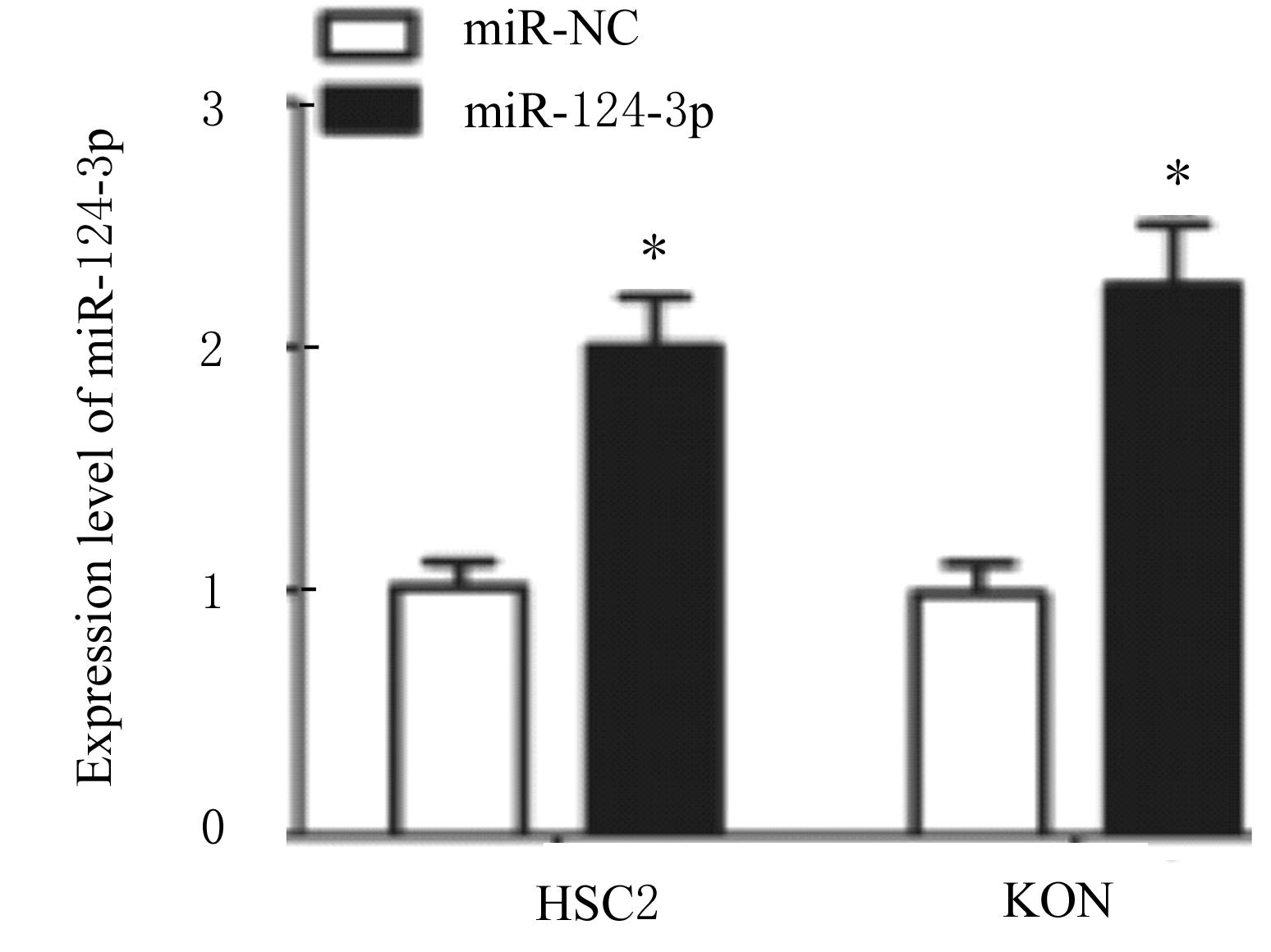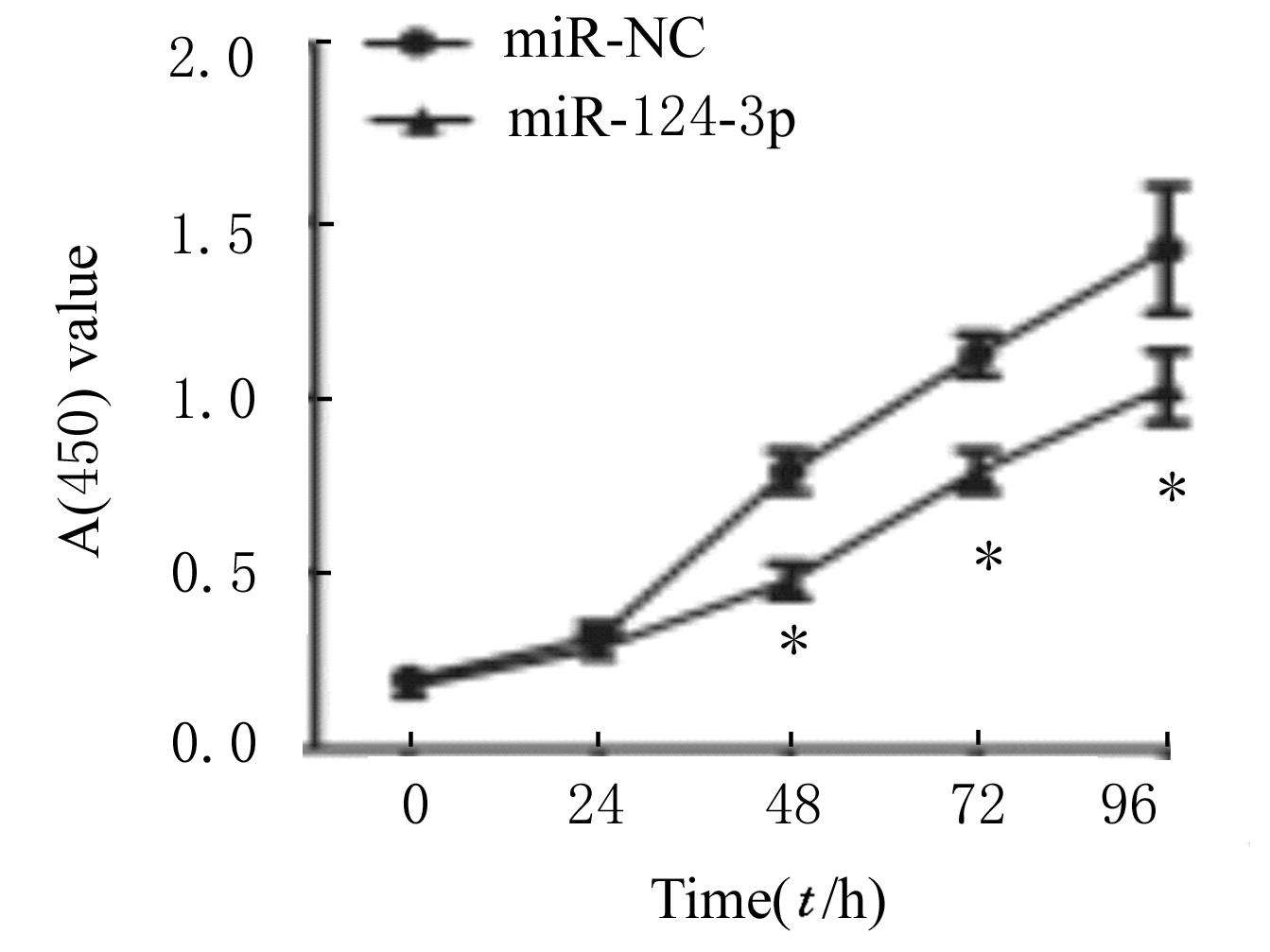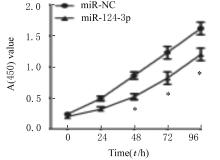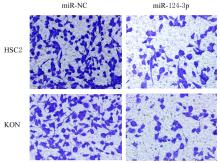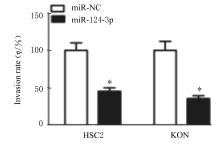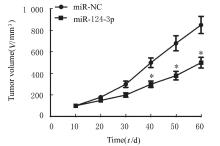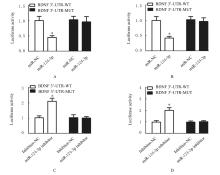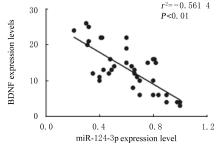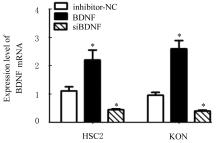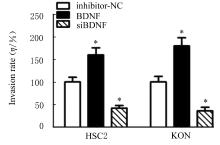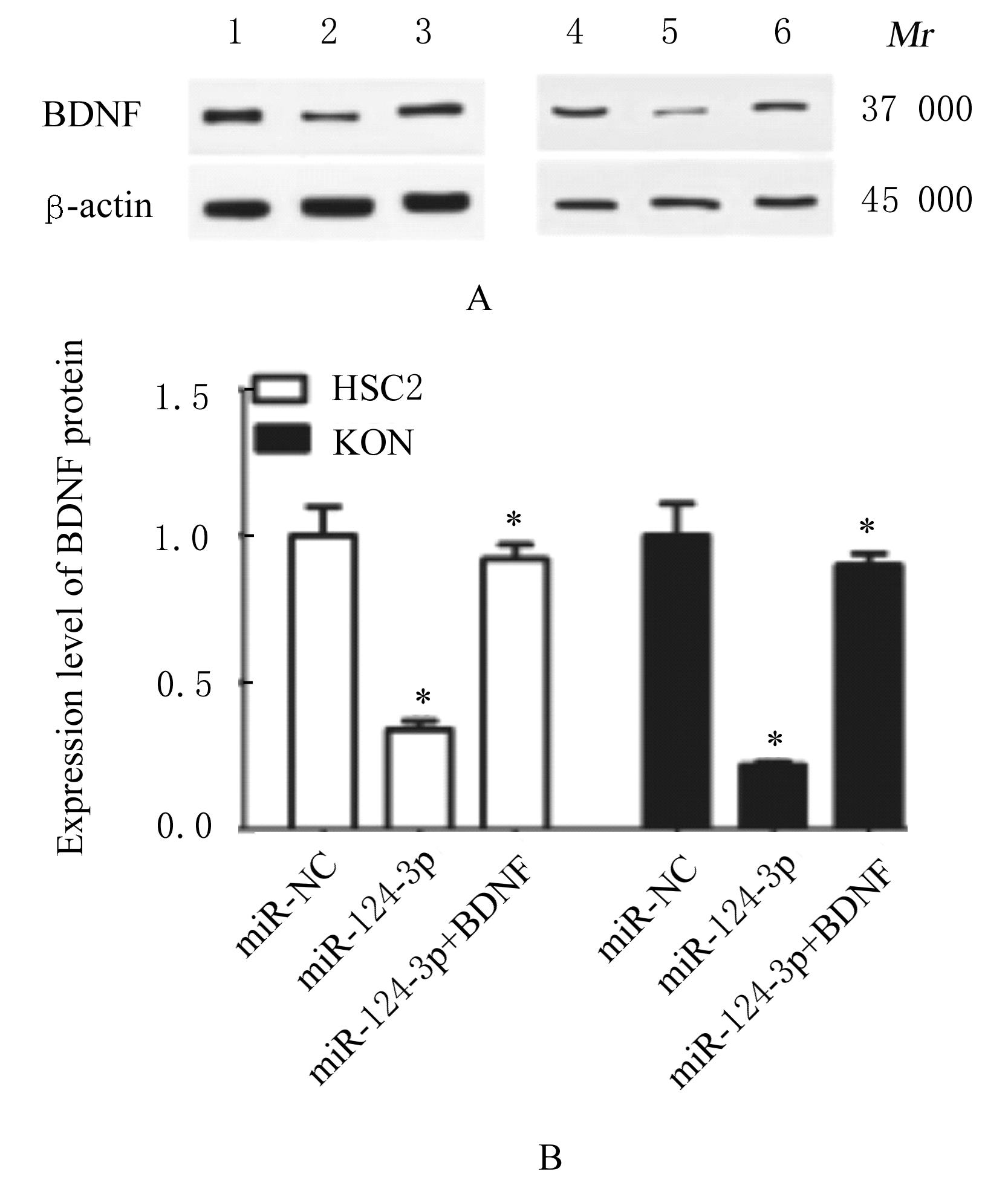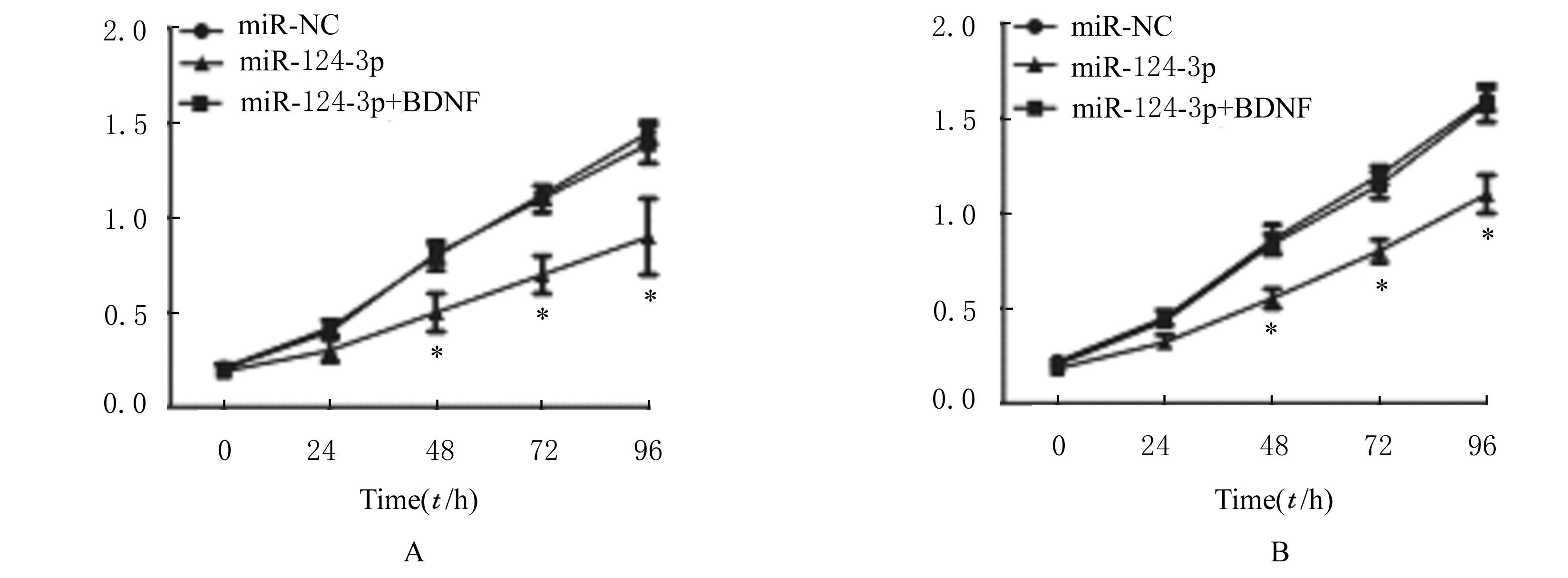Journal of Jilin University(Medicine Edition) ›› 2022, Vol. 48 ›› Issue (3): 718-727.doi: 10.13481/j.1671-587X.20220321
• Research in basic medicine • Previous Articles
Inhibitory effect of miR-124-3p on proliferation and invasion of oral squamous cell carcinoma cells and its mechanism
Zhuangzhi WU,Xiaoning HE( ),Siqi CHEN
),Siqi CHEN
- Department of Stomatology,Second Affiliated Hospital,Hainan Medical University,Haikou 570100,China
-
Received:2021-09-10Online:2022-05-28Published:2022-06-21 -
Contact:Xiaoning HE E-mail:hexiaoningvv@aliyun.com
CLC Number:
- R739.85
Cite this article
Zhuangzhi WU,Xiaoning HE,Siqi CHEN. Inhibitory effect of miR-124-3p on proliferation and invasion of oral squamous cell carcinoma cells and its mechanism[J].Journal of Jilin University(Medicine Edition), 2022, 48(3): 718-727.
share this article
| 1 | 陈 新, 徐文华, 周 健, 等. 口腔鳞状细胞癌现状[J]. 口腔医学, 2017, 37(5): 462-465. |
| 2 | 田晓琳, 杨 臻, 王建英, 等. 微小RNA与肿瘤的关系[J]. 癌症进展, 2016, 14(1): 22-25. |
| 3 | GUO J, WEN N, YANG S F, et al. miR-92a regulates oral squamous cell carcinoma (OSCC) cell growth by targeting FOXP1 expression[J]. Biomedecine Pharmacother, 2018, 104: 77-86. |
| 4 | PENG S Y, TU H F, YANG C C, et al. miR-134 targets PDCD7 to reduce E-cadherin expression and enhance oral cancer progression[J]. Int J Cancer, 2018, 143(11): 2892-2904. |
| 5 | LI X J, HE J Y, SHAO M M, et al. Downregulation of miR-218-5p promotes invasion of oral squamous cell carcinoma cells via activation of CD44-ROCK signaling[J]. Biomed Pharmacother, 2018, 106: 646-654. |
| 6 | WANG Y B, CHEN L X, WU Z Y, et al. miR-124-3p functions as a tumor suppressor in breast cancer by targeting CBL[J]. BMC Cancer, 2016, 16(1): 826. |
| 7 | ZO R B, LONG Z W. miR-124-3p suppresses bladder cancer by targeting DNA methyltransferase 3B[J]. J Cell Physiol, 2018, 234(1): 464-474. |
| 8 | YUAN Y, YE H Q, REN Q C. Proliferative role of BDNF/TrkB signaling is associated with anoikis resistance in cervical cancer[J].Oncol Rep,2018,40(2): 621-634. |
| 9 | 陈 钟, 徐 勇, 张柏梁. BDNF/TrkB在口腔鳞癌浸润和淋巴结转移中的功能[J]. 实用口腔医学杂志, 2011, 27(3): 373-377. |
| 10 | 吕志红, 李学农. 转移相关miRNAs在肿瘤转移中的作用[J]. 国际病理科学与临床杂志, 2012, 32(4): 307-311. |
| 11 | LI Y Y, YAN J, WANG Y T, et al. LINC00240 promotes gastric cancer cell proliferation, migration and EMT via the miR-124-3p/DNMT3B axis[J]. Cell Biochem Funct, 2020, 38(8): 1079-1088. |
| 12 | YANG X Y, WANG J J, LI H F, et al. Downregulation of hsa_circ_0026123 suppresses ovarian cancer cell metastasis and proliferation through the miR‑124‑3p/EZH2 signaling pathway[J]. Int J Mol Med, 2020, 47(2): 668-676. |
| 13 | XU S, ZHAO N, HUI L, et al. microRNA-124-3p inhibits the growth and metastasis of nasopharyngeal carcinoma cells by targeting STAT3[J]. Oncol Rep, 2016, 35(3): 1385-1394. |
| 14 | DENG D N, WANG L, CHEN Y, et al. microRNA-124-3p regulates cell proliferation, invasion, apoptosis, and bioenergetics by targeting PIM1 in astrocytoma[J]. Cancer Sci, 2016, 107(7): 899-907. |
| 15 | WU Q, ZHONG H Y, JIAO L, et al. miR-124-3p inhibits the migration and invasion of Gastric cancer by targeting ITGB3[J]. Pathol Res Pract, 2020, 216(1): 152762. |
| 16 | MAJID A, WANG J X, NAWAZ M, et al. miR-124-3p suppresses the invasiveness and metastasis of hepatocarcinoma cells via targeting CRKL[J]. Front Mol Biosci, 2020, 7: 223. |
| 17 | 乔虎军, 沈勇伟. 脑源性神经营养因子(BDNF)与运动性脊髓损伤[J]. 搏击(武术科学), 2013, 10(1): 116-118, 121. |
| 18 | 黄 靖, 胡 豫, 孙春艳. 脑源性神经营养因子与肿瘤关系的研究进展[J]. 血栓与止血学, 2007, 13(6): 274-276. |
| 19 | LI C, ZENG X, LIU Z, et al. BDNF VAL66MET polymorphism elevates the risk of bladder cancer via MiRNA-146b in micro-vehicles[J]. Cell Physiol Biochem, 2018, 45(1): 366-377. |
| 20 | 胡立威, 陈 炯, 周杭城, 等. 脑源性神经营养因子在胰腺导管腺癌中的表达及其临床意义[J]. 中华胰腺病杂志, 2014, 14(2): 77-80. |
| 21 | LIM W C, KIM H, KIM Y J, et al. Delphinidin inhibits BDNF-induced migration and invasion in SKOV3 ovarian cancer cells[J]. Bioorg Med Chem Lett, 2017, 27(23): 5337-5343. |
| 22 | LONG J T, JIANG C L, LIU B X, et al. microRNA-15a-5p suppresses cancer proliferation and division in human hepatocellular carcinoma by targeting BDNF[J]. Tumour Biol, 2016, 37(5): 5821-5828. |
| [1] | Guowu WANG,Yuan YAO,Yu ZHANG,Na XU,Fang LIU. Inhibitory effect of miR-152 on proliferation and invasion of endometrial carcinoma cells by reducing low-density lipoprotein receptor expression [J]. Journal of Jilin University(Medicine Edition), 2022, 48(3): 591-599. |
| [2] | Guanhu LI,Qingxu LANG,Chunyan LIU,Qin LIU,Mengrou GENG,Xiaoqian LI,Zhenqi WANG. Inhibitory effect of valproic acid combined with X-ray irradiation on proliferation of breast cancer MDA-MB-231 cells and its mechanism [J]. Journal of Jilin University(Medicine Edition), 2022, 48(3): 622-629. |
| [3] | Peiyu YAN,Aichen ZHANG,Hong ZHANG,Yang LI,Mengmeng ZHANG,Mengze LUO,Ying PAN. Therapeutic effect of adipose-derived mesenchymal stem cells on premature ovarian failure model rats and its mechanism [J]. Journal of Jilin University(Medicine Edition), 2022, 48(3): 648-656. |
| [4] | Cuilan LIU,Fengai HU,Jing LIU,Dan WANG,Changyun QIU,Dunjiang LIU,Di ZHAO. Effect of adiponectin receptor agonist AdiopRon on biological behaviors of glioma cells and its mechanism [J]. Journal of Jilin University(Medicine Edition), 2022, 48(3): 702-710. |
| [5] | Xiaoyan LI,Wei ZHANG,Jie HE. Promotion effect of REG1A on proliferation and migration of lung adenocarcinoma cells by regulating Wnt/β-catenin signaling pathway [J]. Journal of Jilin University(Medicine Edition), 2022, 48(2): 444-453. |
| [6] | Guangsong XU,Haibing JIANG,Jing PAN,Guoqing LI. Inhibitory effects of betulinic acid on migration and invasion of gastric cancer MGC-803 cells and their mechanisms [J]. Journal of Jilin University(Medicine Edition), 2022, 48(1): 122-128. |
| [7] | Chaofeng ZHOU,Shifan ZHOU,Qing TIAN,Sai WANG,Honglin LI,Chunzheng MA. Effect of lncRNA-NORAD overexpression on biological behaviors of esophageal cancer Eca-109 cells and its mechanism [J]. Journal of Jilin University(Medicine Edition), 2022, 48(1): 33-43. |
| [8] | Naigao TANG,Genjian ZHENG. Effects of miR-762 on proliferation and apoptosis of human tongue squamous cell carcinoma cells by targeting NCOR1 expression [J]. Journal of Jilin University(Medicine Edition), 2021, 47(5): 1099-1107. |
| [9] | Yajie CAO,Xiaohong BAO,Shuzhen LI,Haiying GENG,Zengxiaorui CAI,Chunmei DAI,Ning LI. Effects of insulin-like growth factor 1 receptor inhibitor NVP-AEW541 on proliferation, migration and invasion of ESCC cells [J]. Journal of Jilin University(Medicine Edition), 2021, 47(5): 1131-1138. |
| [10] | Lisong CHEN,Hui FANG,Hefei WANG,Chengyuan HE,Xiaodong GAI,Chun LI. Effects of Notch1 signaling pathway on invasion and cisplatin resistance of lung adenocarcinoma cells and their mechanisms [J]. Journal of Jilin University(Medicine Edition), 2021, 47(5): 1171-1177. |
| [11] | Chen WANG,Jun TIAN,Hailing CHENG. Effect of human umbilical cord mesenchymal stem cells on proliferation and apoptosis of cervical cancer HeLa cells and its mechanism [J]. Journal of Jilin University(Medicine Edition), 2021, 47(5): 1187-1193. |
| [12] | Meng QU,Shiya WENG,Hong ZHENG,Yan LI,Runze GAO,Shenggao WANG,Chunyan YU,Boxue CHEN,Zhiheng DONG. Protective effect of fermented red ginseng total saponins on rat myocardial interstitial fibroblasts cultured with high glucose and its mechanism [J]. Journal of Jilin University(Medicine Edition), 2021, 47(5): 1201-1208. |
| [13] | Siyu LI,Min ZHAO,Maoling YANG,Nong XIAO,Wei JIANG. Regulatory effect of retinoic acid on proliferation of hippocampal neural stem cells after hypoxic-ischemic brain damage in rats via GSK-3β [J]. Journal of Jilin University(Medicine Edition), 2021, 47(5): 1077-1085. |
| [14] | Lijing QIN,Bing HAN,Zhongqi LI,Qi SUO,Zhen JIA,Hongli CUI,Weiqiang XU,Fang FANG,Zhicheng WANG. Effects of targeting-silenced ATRX on cell cycle arrest and apoptosis induced by radiation in cervical cancer HeLa cells [J]. Journal of Jilin University(Medicine Edition), 2021, 47(4): 904-910. |
| [15] | Dongli ZHANG,Ruifang FU,Guixia SUN. Effect of oxymatrine on proliferation and apoptosis of cervical cancer SiHa cells and its mechanism [J]. Journal of Jilin University(Medicine Edition), 2021, 47(4): 951-957. |
|
||



